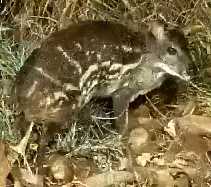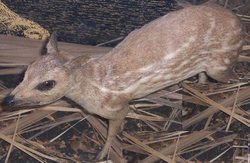New Mouse-Deer
Posted by: Loren Coleman on March 20th, 2008

In the West, we know the above pictured species as a chevrotain or musk-deer. In the East, they are sometimes called mouse-deer.

One of Sri Lanka’s least known mammals, the mouse-deer found in the highlands of Sri Lanka has been photographed in the wild. This may well be the only occasion in which it has been photographed to a ‘publishable standard’ under truly wild conditions.
For many years it was believed that Sri Lanka had one species of Mouse-deer, which was shared with Southern India.
Colin Groves a British Taxonomist in June 2005 published a paper in a special supplement (No 12) of The Raffles Bulletin of Zoology whereby he distinguished three species of Mouse-deer from Sri Lanka and India. The Indian Mouse-deer (Moschiola indica) was split as a new species and is now considered endemic to the Eastern Ghats of India. The mouse-deer found in Sri Lanka was split into two new species. The White-spotted Mouse-deer found (Moshiola meeminna) in the dry zone of Sri Lanka and the Yellow-striped Mouse-deer (Moschiola kathygre) found in the wet zone of Sri Lanka. Both species are endemic to Sri Lanka. Presently this raises the number of endemic mammals found in Sri Lanka to eighteen species.
Colin Groves in his paper on mouse-deer from India and Sri Lanka also stated that ‘a single skull from Sri Lanka’s Hill Zone may prove to represent a fourth species’. The ‘Mountain Mouse-deer’ is evidently a very scarce animal. Many of the field staff of Horton Plains National Park had not seen one although they regularly encounter other nocturnal mammals including leopard.
A Mountain Mouse-deer was seen under quite dramatic circumstances on Monday 25th February 2008 by wildlife populariser Gehan de Silva Wijeyeratne and Nadeera Weerasinghe the naturalist of St Andrew’s Hotel. They had agreed with the park warden Mr Y.G.P. Karunarathne to spend a few hours on an informal training session on butterflies and dragonflies for the staff manning the Pattipola Gate to the Horton Plains National Park. They were engaged in identifying some of the dragonflies at the pond besides the ticket office when an animal came running and jumped into the pond and swam towards them. It was the hardly ever seen Mountain Mouse-deer! It was being pursued by a Brown Mongoose, about a third of its size in height. The mouse-deer swam back to the far shore and faced off with the Mongoose. The Mongoose did not enter the water but at times approached within five to six feet of the mouse-deer which responded by flaring its throat and showing the white on its throat. After fifteen minutes the mongoose seemed be tired of the chase and left.
The Mouse-deer left but returned soon with the mongoose in pursuit and once again dived into the pond. The mouse-deer seemed at ease in the water and even seemed to be adapted for an occasional bout of underwater swimming. Forty five minutes later the hunter and the hunted to be left and Gehan de Silva Wijeyeratne and Nadeera Weerasinghe informed the park warden Mr Y.G.P. Karunarathne. Around 5 pm the mouse-deer was seen again by the park warden and his staff. Around 6pm, offering no resistance, it was taken in for safe custody. It had a small gash near the ear and was in an exhausted state.
Given the significance of the live specimen, Gehan de Silva Wijeyeratne after consultation with the park warden informed several scientists of the mouse-deer being temporarily held captive. On Wednesday 27th February 2008, two scientists traveled up with Nadeera Weerasinghe to take measurements and to take a blood sample for analysis. Dr Tharaka Prasad the Deputy Director (Veterinary) of the Department of Wildlife Conservation and Dr. Prithiviraj Fernando who has worked on conservation genetics of elephants and other mammals (www.ccrsl.org), examined the mouse-deer which was released back into the wild later that day. The mouse-deer was found to be a pregnant female and measured 56 cm in length. This places is the upper end of all specimens of mouse-deer which have been measured. It is likely that as more time is spent on bio-diversity exploration and sophisticated techniques are employed more cryptic species of mammals may be discovered. Local researchers and wildlife enthusiasts are also benefiting from further insights into species which are familiar but about whom little have been published.
A case in point are Sri Lankan primates about whose ecology more awareness has been raised thanks to the interest of overseas nationals. Observational studies, even if conducted on public land by visitors, can lead to many insights.
It can also stimulate local researchers into undertaking and publishing their own studies. It also opens possibilities for collaboration so that ‘know how’ and funds can be shared for studies on mammals. Especially with taxonomic work, collaboration with foreign researchers plays an important part in meeting the requirement to examine type specimens lodged in overseas collections.
Source: Daily Mirror, New endemic mammal found in Lanka/Mountain Mouse-Deer in Horton Plains
Colin Groves was an original member of the board of directors of the now-defunct International Society of Cryptozoology.

About Loren Coleman
Loren Coleman is one of the world’s leading cryptozoologists, some say “the” leading living cryptozoologist. Certainly, he is acknowledged as the current living American researcher and writer who has most popularized cryptozoology in the late 20th and early 21st centuries.
Starting his fieldwork and investigations in 1960, after traveling and trekking extensively in pursuit of cryptozoological mysteries, Coleman began writing to share his experiences in 1969. An honorary member of Ivan T. Sanderson’s Society for the Investigation of the Unexplained in the 1970s, Coleman has been bestowed with similar honorary memberships of the North Idaho College Cryptozoology Club in 1983, and in subsequent years, that of the British Columbia Scientific Cryptozoology Club, CryptoSafari International, and other international organizations. He was also a Life Member and Benefactor of the International Society of Cryptozoology (now-defunct).
Loren Coleman’s daily blog, as a member of the Cryptomundo Team, served as an ongoing avenue of communication for the ever-growing body of cryptozoo news from 2005 through 2013. He returned as an infrequent contributor beginning Halloween week of 2015.
Coleman is the founder in 2003, and current director of the International Cryptozoology Museum in Portland, Maine.










cute, but not enough meat for me. Someday I will get to hunt a moose.
I have images of the mountain mouse-deer being chased via permission from the photographer at my site http://www.conservationreport.com/ or here
http://www.conservationreport.com/2008/03/one-of-sri-lankas-least-known-mammals.html
Thanks for the amazing pictures, Conservationreport. She really does look like a very natural swimmer. Fantastic. And, as always, thanks for the great article, Loren.
I remember reading about mouse-deer as a kid, about 20 years ago. Obviously, they were refered to as chevrotain, and there was no mention of different sub-species. In fact, they were not even acknowledged to live in Sri Lanka, only India. This may just have been poor writing, but the rest of the book (on a variety of different creatures, and which I had kept until about 6 years ago) was very well researched.
Well, it’s great to hear about these apparently diverse little dudes.